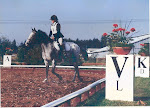 Excerpt from http://www.horsemanpro.com/articles2/hand-aid-inhand.htm
Excerpt from http://www.horsemanpro.com/articles2/hand-aid-inhand.htmGenuine Rider: (read more)
The hands operate the clutch, the seat the gearbox, leg aids, among others, are the gas pedal (RPMs). The breaking and the direction of going is managed by all aids working harmoniously together. (The leg aids have a dual functions (also guiding), separate issue in the article "Leg Aids"). There is simple no steering wheel or brakes and in genuine riding it is about collecting and releasing (managing) the horse's energy in the desired directions, whether left, right or up. The stopping or slowing down is done by releasing less energy than collected, hence the stopping or slowing down horse is, throughout the downward transition, more collected than in previous gait and speed, the same goes for the acceleration.
Uncollected and unbalanced horses have difficulty in slowing down or in accelerating, but most will manage.
In the light seat the leg aids are almost useless and are hardly used, while the hands take over their function in adding or reducing the collection, gathering and releasing energy (RPMs and clutch). During the light seat the seat aid becomes limited and again the hands take over the part that the seat can no longer do.
Henceforth the hand aid of a rider is the most important part in riding and takes a lifetime to refine. Now when you will hear some one say: " I can ride my horse without hands", you will not need anyone to tell you just how stupid that sounds. All these riding aids must be implemented harmoniously as when driving the car (gas, gear, clutch), otherwise similar problem occurs as when driving the car, however in much more accelerated speed.
People riding on the so-called contact are actually the same people that are riding the clutch, or people leaning back are "frying the gears", both interfering with the horse's movement. Too much RPM will burn out the engine and tires (gaited horses, specifically Paso Finos present wasted energy when on the go, also need often frequent reshoeing of the rear shoes).
Hanging on the mouth will burn out the clutch (horses pull or hang their heads in the rider's heavy hands, which present a difficulty in shifting gears (transitions)) and so on and such. As the clutch burns out (the jaw stiffens up) it becomes difficult to shift from one gear to another by the car, as well as, by the horse. Once when this happens horses do not respond to the seat aid, unless the seat is implemented via forceful fashion by interfering with the horse's back, to which these nincompoops refer to as driving the horse forward via the seat. Hogwash! (More in the "Seat Aid" article). This brutal way of riding can be noticed in the collapsed lower back of the rider that sits far on his ass, which is then obviously and always accompanied by the bit being below the hip line.
All in all when we are speaking of riding in harmony there are two elements that must be in harmony, the riders aids, or better said his riding with the horse's motion and energy. In the so-called trick riding (using riding aids as some cues) the horse responds to the aids. Hence the rider thinks of something, implement certain aid and the horse responds, or he may wish he would.
In the genuine riding the implementation of aids is not determined by the rider but by the horse. Hence the fine rider uses his riding aids within the motion of the horse and not out of it, as it is in the "cue style" riding aids application.








No comments:
Post a Comment